If you are interested in raising chickens, the Plymouth Rock chicken is an ideal choice. This American chicken breed has a colorful history and is one of the best multi-purpose birds in the world.
It was admitted to the American Poultry Association (APA) Standard of Perfection in 1874. Since then, this breed has attracted a lot of chicken enthusiasts.
Plymouth Rock chickens are good egg layers. They can lay up to 300 eggs a year or 5 to 6 eggs a week. Most of their strains also continue laying eggs during winter. Like most breeds, Plymouth Rock hens lay eggs continuously in the first three years and reduce gradually in the succeeding years.
The Plymouth Rock chicken is one of America’s favorite chicken breeds and is also one of the oldest breeds in the country. No wonder it has been one of the foundations of the broiler industry from the 1920s until World War II.
This comprehensive guide will teach you everything about Plymouth Rock chickens and might convince you to have one.
Where Do Plymouth Rock Chickens Originate?
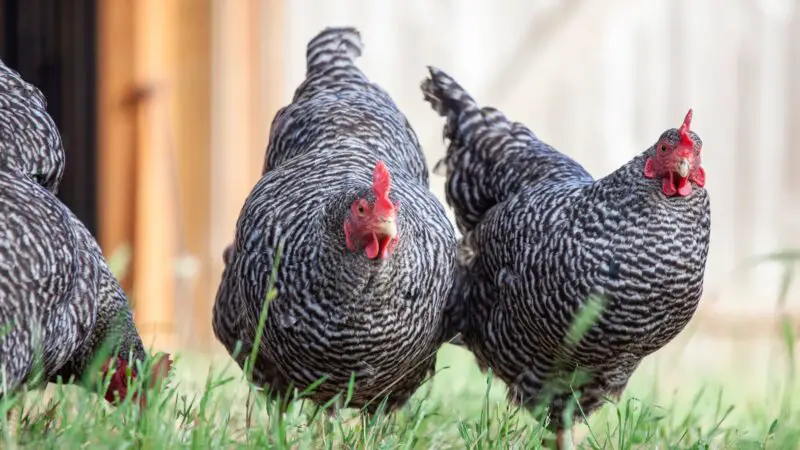
The Plymouth Rock chicken is an American breed that was first seen in Massachusetts in 1829 and became popular until the mid-19th century.
Although there is no proof, the original Plymouth Rock chickens were believed to be a product of crossing several breeds. This includes the Brahma, Black Java, Dominique, Spanish, and White Cochin.
Plymouth Rock Chicken History
The first and most accepted origin of the Plymouth Rock chicken is that it was created by crossing a male Dominique (not the original American or Rose-Comb Dominique) and Black Cochin or Black Java hens.
This chicken breed first appeared in an exhibit in Boston in 1849 but somehow lost its identity and disappeared for almost two decades.
The Plymouth Rock chicken returned sometime in 1869. This is after D.A. Upham of Worcester, Massachusetts presented the bird in a poultry show.
This time, the chicken breed was said to be a cross of a Barred Rock male with a single comb and some Black Java hens. It is also believed to be the ancestor of the Plymouth Rock we know today.
Are Plymouth Rock Chickens Rare?
Most of the color varieties of Plymouth Rock chickens are rare, except for the white and the barred type. As of November 2022, the Livestock Conservancy listed the Plymouth Rock chicken as “Recovering.” It means that the breed was once listed in another category but has exceeded the “Watch” category. The population still needs monitoring, though.
Plymouth Rock Chicken Identification
What Do Plymouth Rock Chickens Look Like?
The Plymouth Rock chicken is a large breed with pale red eyes, a long, broad back, and moderately deep, rounded breasts. It has a single, medium-sized comb with five well-defined points, round wattles, and oblong earlobes, which are all bright red. This breed has a yellow beak and legs that have no feathers. Each foot has four toes.
There are eight different color varieties of Plymouth Rock chickens – barred, black, blue, buff, Columbian, partridge, silver-penciled, and white.
All of them are recognized in the United States, but only the Barred Rock and the White Plymouth Rock are popular. Barred Plymouth Rock chickens have black and white bar feathers, hence the name.
What Is the Difference Between Barred Rock and Plymouth Rock?
The Barred Rock is one of the eight color varieties of the Plymouth Rock chicken breed and is also the oldest. Hence, all Barred Rocks are Plymouth Rock chickens, but not all Plymouth Rocks are Barred Rocks.
The Barred Plymouth Rock is the most famous variety, followed by the White Plymouth Rock, which was accepted by the APA in 1888.
How Long Does a Plymouth Rock Chicken Live?
Plymouth Rock chickens are a tough breed and have a long life. When treated well, hens can live between 10 and 12 years.
Nonetheless, their average lifespan is 5 to 8 years. On the other hand, the bantam versions live shorter, which is expected due to their smaller sizes.
How Big Do Plymouth Rock Chickens Grow?
While there are no documents showing the exact size of Plymouth Rock chickens, they are considered huge compared to other backyard chickens. No wonder this breed is ideal for meat production. In fact, Barred Rocks as young as 16 weeks old can already be butchered.
Are Plymouth Rock Chickens a Heavy Breed?
Plymouth Rock chickens are not only big; they are also heavy birds. Roosters have an average weight of 9.5 lbs (4.3 kilos), and hens weigh about 7.5 lbs (3.4 kilos). This breed is slightly heavier than Dominique chickens.
Meanwhile, bantam roosters have an average weight of 36 oz (1 kilo), while bantam hens weigh about 32 oz (900 grams).
Plymouth Rock Chicken Wingspan
So far, there are no records about the wingspan of Plymouth Rock chickens. This is probably because these heavy birds are not known for flying high and frequently.
How to Tell Male From Female Plymouth Rock Chickens?
Plymouth Rocks are considered sex-linked chickens, which means that you can identify their gender while they are still chicks. For pure-bred Barred Rocks, one-day-old male chicks have a large white spot on top of their heads, while female chicks have a smaller spot. This sexing method has been tested and proven to be around 80% accurate.
Meanwhile, Barred Rock roosters have equal black and white barring, and each feather has a dark tip. On the other hand, their hens have slightly wider dark bars compared to the white bars.
Therefore, adult males may look darker than adult females. For White Plymouth Rocks, roosters have bigger and redder combs and wattles than hens have.
Can Plymouth Rock Chickens Fly?
Plymouth Rock chickens can fly, but at a very limited distance and height. Most of them are not strong fliers as compared to lighter breeds.
Some chicken farmers may claim otherwise, but considering their size and weight, Barred Rocks will have difficulties flying over high fences.
What Is Plymouth Rock Chicken Known For?
The Plymouth Rock chicken is excellent both in laying eggs and meat production. They were originally used to produce commercial broilers.
Since their meat is tasty, you can still buy them now from grocery stores. A fully grown-up Plymouth Rock chicken has a market weight of 6-8 lbs (2.7-3.6 kilos). This dual-purpose bird makes great pets, too.
What Are the Distinct Characteristics of a Plymouth Rock Chicken?
Plymouth Rock chickens are uniquely beautiful and elegant. They have thick feathers, which make them look bigger than their actual sizes.
The points in their combs are also evenly separated, while the middle point is longer than the endpoints. This amazing look is unusual for most chicken breeds, making this American breed very special.
What Do Plymouth Rock Chickens Eat?

Plymouth Rock chickens don’t have any special dietary requirements. You can feed them with the same food you give to other chickens.
But because they are huge and are egg layers, newborn chicks need more starter feeds with lots of protein and minerals. Hens should be properly fed with layer feeds so their eggs will have stronger shells.
Are Plymouth Rock Chickens Friendly?
Plymouth Rock chickens are very friendly and can live happily with people and small children. They enjoy human attention, love to be touched and cuddled, and sit on laps voluntarily.
Despite being large birds, Barred Rocks are also kind to other breeds, and they thrive well in a mixed flock. But then, mixing different breeds is not advisable.
Are Plymouth Rock Chickens Aggressive?
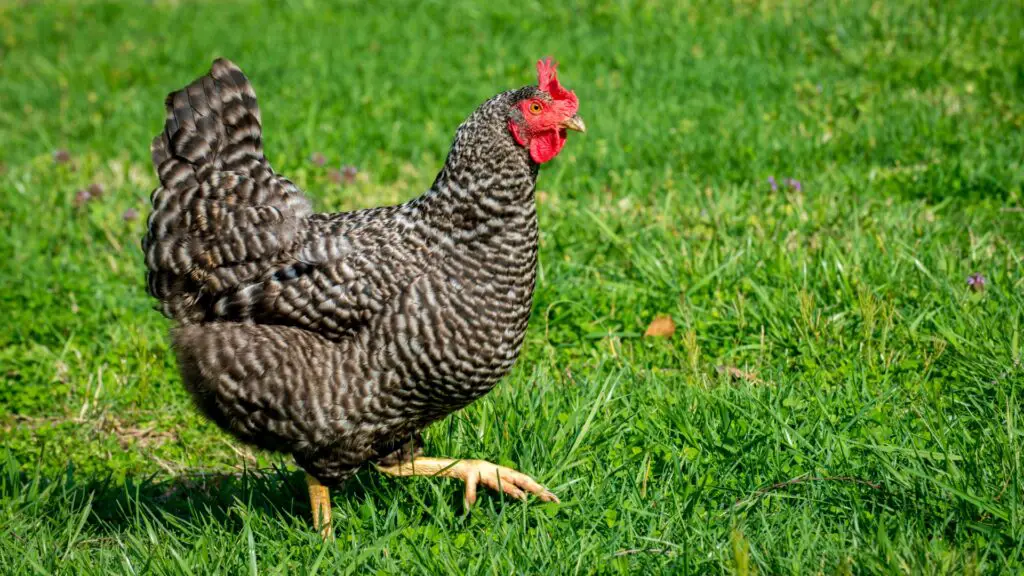
Plymouth Rock chickens are not aggressive in general. Aside from being sweet and friendly, they are also calm and docile. They are active, curious, and will follow you, especially if you have some treats for them.
But like other breeds, both sexes can be a bit assertive if you mix them with other breeds. They are unlikely to start a fight, though.
Are Plymouth Rock Chickens Loud?
Plymouth Rock chickens are not considered loud or noisy. Roosters crow, but not as noisy and as frequent as other breeds.
But as expected, hens can be a bit noisy before, during, or after laying eggs. The singing of the “egg song” is very common to all chicken breeds.
Are Plymouth Rock Chickens Good Egg Layers?
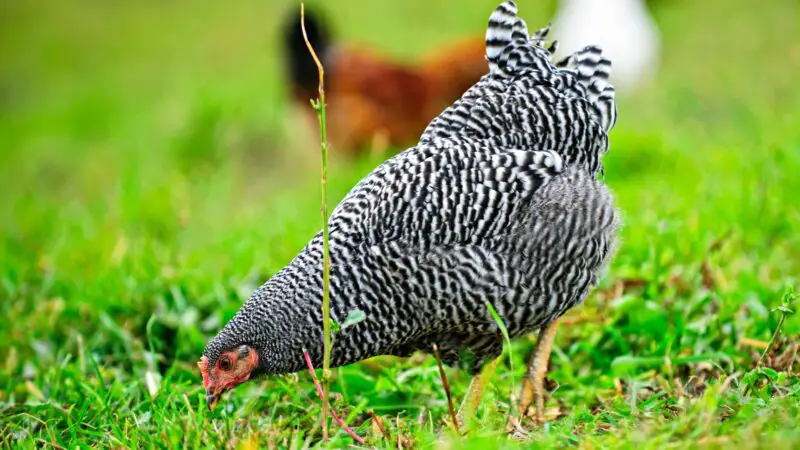
Plymouth Rock hens are known for being excellent egg layers. As mentioned earlier, Barred Rocks are dual-purpose birds. This trait is believed to have come from their supposed ancestor, the Dominique chicken.
What Age Do Plymouth Rocks Start Laying?
Plymouth Rock pullets will start to lay eggs once they are 16-20 weeks old. This is also the standard age for most chicken breeds.
Your pullets are ready to lay eggs if their comb, wattles, and vent are getting redder and larger. They will also squat if you place your hand on their backs without touching them, even if there is no rooster around.
How Many Eggs Do Plymouth Rock Chickens Lay?
Plymouth Rock hens lay between 200 and 300 large eggs a year, which equates to 4 to 6 eggs a week. This makes them one of the most productive egg producers in the world.
How Often Do Plymouth Rock Hens Lay Eggs?
After their first eggs, Plymouth Rock hens usually lay continuously until their third year. In their fourth year, the frequency is likely to decline gradually. However, some strains may still lay eggs until they are 8-10 years old.
What’s the Color of Plymouth Rock Chicken Eggs?
Plymouth Rock hens lay light brown to brown eggs, regardless of the color of their feathers. Contrary to what some people may think, the feather color of chickens has no relation whatsoever with their eggshell color. Instead, it depends on the breed. This is why some colored chickens lay white eggs and White Plymouth Rock hens lay brown eggs.
Are Plymouth Rock Chickens Broody?
Generally speaking, Plymouth Rock hens are known for being less broody compared to other breeds. Nevertheless, some strains may tend to be very broody at some point, while others don’t go broody at all.
In short, don’t expect all Barred Rocks to always sit on their eggs. But if you prefer having chicks instead of eggs, buy a reliable incubator.
Breeding Plymouth Rock Chickens
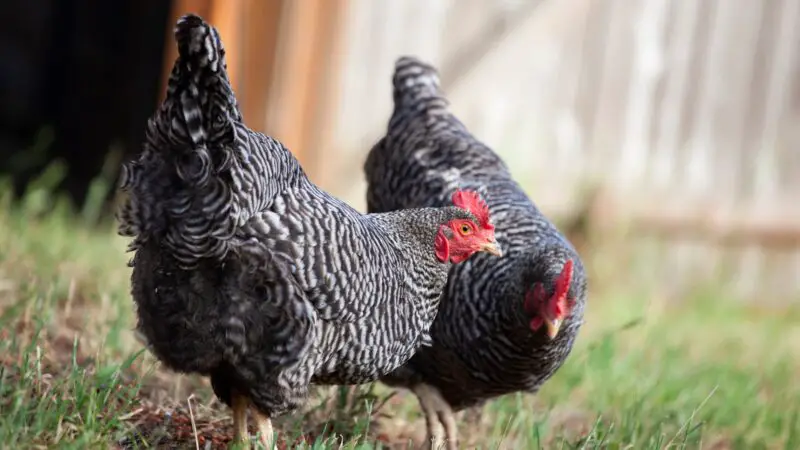
Breeding Plymouth Rock chickens is not as difficult as you think. To start with, they are sturdy birds and don’t have a particular health issue.
Despite being active birds, you may not need to build high fences since they are not flighty in general. You also don’t have to worry about noise. And more importantly, small children can play with them.
Plymouth Rock Chickens Care Tips
Plymouth Rock chickens don’t require special care. They are cold and hardy and can also tolerate the heat of summer. Yet, you should still put petroleum jelly on their combs to protect them from frostbite.
This versatile breed is also suitable for both free-ranging and confinement. They are intelligent, alert, and can easily escape from predators.
But like other breeds, Plymouth Rock chickens are also prone to bumblefoot. Also called pododermatitis, this foot injury is due to bacteria and is very common in chickens.
To help prevent bumblefoot, always keep their coop and beddings clean and dry. These chickens should also be free from internal and external parasites such as mites and fleas.
How Much Is a Plymouth Rock Chicken?
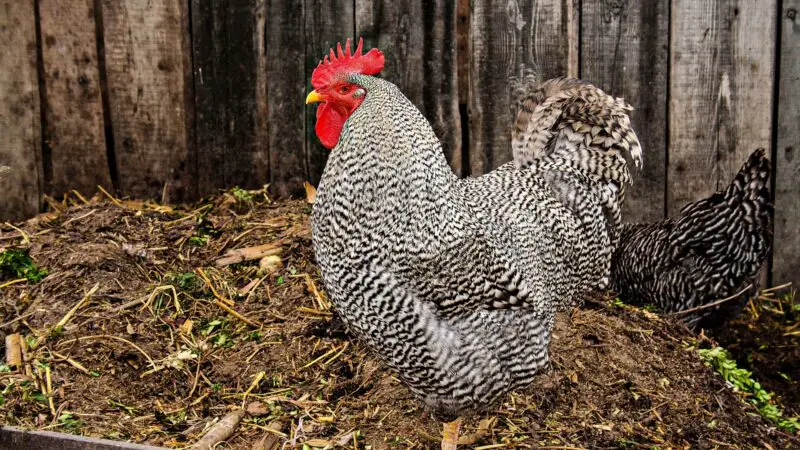
The price of Plymouth Rock chicks usually depends on the quantity you will purchase. As of November 2022, a male chick can cost between $2.44 and $3.15.
A female chick costs between $3.68 to $4.76, while an unsexed chick costs between $2.92 and $3.78. The more chicks you buy, the cheaper they are. Buy only from reputable hatcheries.
Related Questions
Do Chickens Recognize Their Owners?
Chickens can recognize their owners. In fact, they can remember more than 100 human faces even after they have been separated for several months.
Depending on how often you bond with your chickens, they can get excited once they see you. This is why Plymouth Rock chickens sit on their owner’s lap or perch on their shoulders.
Do Hens Show Empathy to Their Distressed Chicks?
Hens show empathy to their chicks when they are mildly distressed. According to a 2011 study, domestic hens became more alert, and their heart rate increased when air puffs were directed at their chicks.
The worried hens also responded intensely, and their eye temperature was reduced even if their chicks did not make a distress call at all.
List of Sources
Avian Maternal Response to Chick Distress
